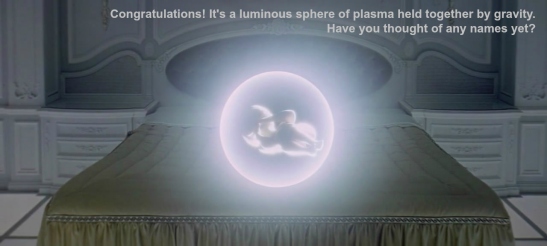My God, its Full of Sex: A Puerile Reading of 2001 A Space Odyssey
A couple of years ago I started seeing things in 2001: A Space Odyssey.
Is she dressed as a sperm?
Rude things.
Are they rubbing a giant alien clitoris?
Giggle-inducing things.
Did he just ejaculate himself into a spaceship’s vagina?
Afterall, Kubrick’s previous film pulled-off a similar trick. Strip away Dr Strangelove‘s reputation as a meticulously researched political satire and you’ll find jokes aplenty about masturbation and flatulence, as men of great importance and greater impotence unleashed their phallus’s of mass destruction in a global pissing contest.
2001‘s deliberate ambiguity, and Kubrick’s refusal to spell out exactly what was going on, invites audiences to speculate on possible deeper meanings and, in the process, reveal something of themselves. Some see a religious or Nietzschean allegory, others an updating of Homer’s Odyssey (with HAL9000 as the Cyclops). I see a kind of existential intergalactic sex romp and (more importantly) a chance to write about two of my favourite things; science fiction and genitalia.
The first two sections of the film, Dawn of Man & TMA-1, cover sexual awakening and discovery and are straightforward enough for the reading to work from the get go. For the remaining chapters, Jupiter Mission & Jupiter and Beyond the Infinite, things get messier as the emphasis shifts to what comes after sex; conception, gestation, jealousy, paranoia, marriage, murder, death and birth. So that it might actually mean something, my reading will attempt to draw all of these themes and threads together into the unified narrative of an individual’s sex life from adolescence to parenthood. Finally, even if this reading comes apart like wet cake, I’ll wager that it will at least help you see this masterpiece in a new, if slightly grubby, light.
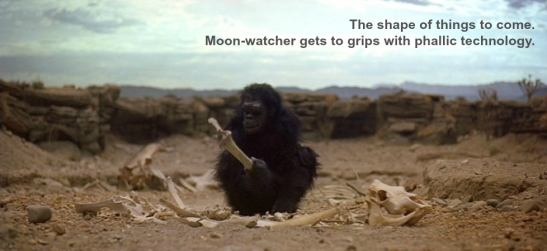
Sometimes a cigar is just a cigar, but, for my purpose, a wild man-ape discovering the joys of playing with a bone marks a coming of age and heralds an age of coming. The appearance of the monolith signifies a sudden awakening of desires and the bone phallus is the means of satisfying them. When wielded by the protagonist man-ape (named Moon-watcher in the novel), it becomes a blunt tool for bashing but more significantly it is a symbol of power, authority, control and an everlasting erection to represent inexhaustible male desire. If the early experimentation with the bone phallus is a formative act of masturbation, when it is put to the test to bludgeon other animals and rival apes, we see a violent representation of sex. What is conceived by this union is technological progress and the chance to shake-up the food chain by becoming stronger, faster and smarter. Or to put it another way, by becoming human.
In the seminal match-cut from the rising bone, launched into the air by Moon-watcher in the Pleistocene Era, to the falling satellite four million years later, the phallic status is transferred from the weapon to the means of space-travel. If early metaphorical sex was brief and brutal, by the start of the 21st Century it has developed into a far more sophisticated and considerate affair. In an extended docking sequence, an intricate dance of love is performed by the Pan-Am shuttle Orion and the Hilton Space Station 5 to a soundtrack of On the Beautiful Blue Danube. The dance ends in penetration and as if to emphasis the Orin‘s phallic status and the scene’s overtly sexual nature, the cabin crew are dressed as sperm.
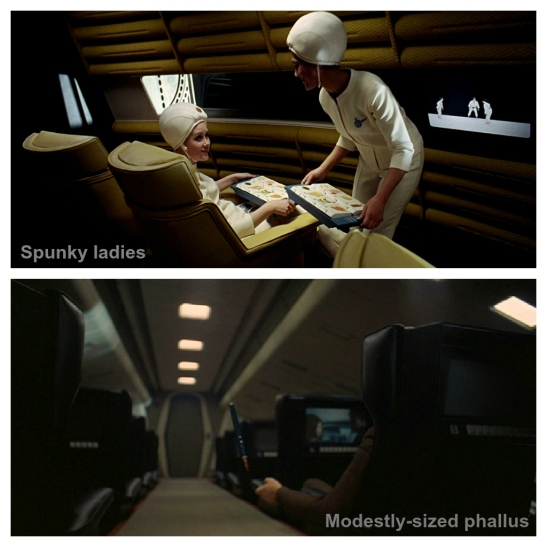
The phallic status of Moon-watcher’s bone is also echoed in the fountain pen floating toward the vaginal doorway within Orion. Although modestly sized, its symbolic power has increased enormously, not through violence but education, communication and knowledge. Its owner is Orion‘s sole passenger, and the protagonist of this segment of the film, Dr Heywood Floyd, en route to Tycho Magnetic Anomaly One (TMA-1) the formal name given to the second monolith recently discovered buried beneath the surface of the moon. Like Moon-watcher, Dr Floyd is the leader of his community, having total control of America’s astronautic programme, and, by calmly blocking a Soviet counterpart’s repeated requests for information regarding the mysterious activity on the moon, is shown defeating a rival.
The possibility of contact with extraterrestrial lifeforms is embraced by Dr Floyd as an incredible opportunity for all humanity. This lack of the machismo (and, by association, violence) places 2001 in opposition to Cold War-era science fiction in which aliens were portrayed as threats to be countered with military might. If this reflects a concern for preserving the social order in the 1950s and early 1960s films, 2001 embraces the tumultuous social upheaval at the time of its release, specifically sexual liberation and the quest for gender equality. This contrast is also present in the use of sexual imagery.
Reflecting the patriarchal and colonial values of the 1950s, the final frontier, like the wilderness in Westerns, was often coded as feminine – a mysterious, dangerous and indefinable Other to be tamed and colonised by male astronauts in their pointy rockets. Whilst the shuttle Orion is classically phallic, it is positively tiny in comparison to the space station’s docking bay. In a spirit of sexual equality, much of the sexual imagery in 2001 is refreshingly vaginal.
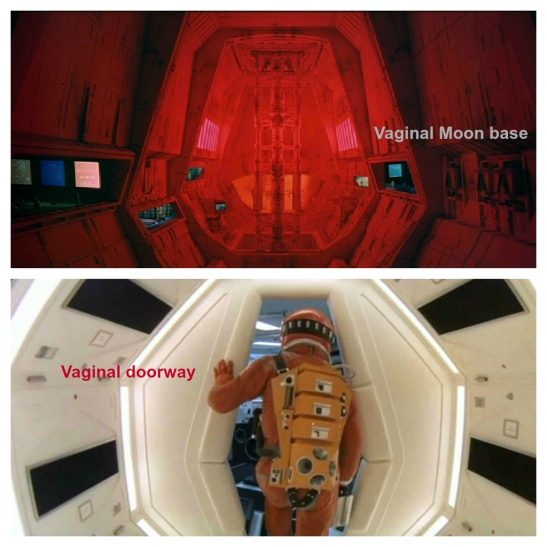
Another key vaginal opening awaits Dr Floyd upon the moon. Located at the end of a deep pit is the TMA-1 monolith, which Dr Floyd approaches with great trepidation and instinctively rubs. A few seconds later it sings out in orgasmic pleasure with a high-pitch electronic sound aimed at Jupiter. The monolith reveals itself to be a cosmic clitoris, signalling that if mankind is willing to venture deep into space to make contact, the serious and lengthy business of impregnation can begin.
Emphasising the second half of the film’s shift from sex to birth, the unmistakably sperm-shaped Discovery One spaceship takes the epic and perilous journey to Jupiter which will eventually result in the creation of the Star Child. Man’s relationship with technology, one which started with Moon-watcher and that bone, has come a very long way (around four million years and half a billion miles) but has turned decidedly sour. Before mankind can get cosy with aliens and make serene space babies, they must get their spaceship in order by ridding themselves of an all-seeing psychotic ex.
On board Discovery One we have a vision of a future in which mankind has become dehumanized whilst the most advanced technology has evolved to such a level that it is capable of increasingly complex emotional behaviour. Doctors Dave Bowman and Frank Poole are the two members of the scientific team not cryogenically frozen for the 18 month journey, and yet they display a cold machine-like rationality. Their emotions, it seems, are as contained and controlled as their use of language. In stark contrast to Dave and Frank’s flat, banal and jargon-heavy dialogue, the ship’s all-powerful and sentient computer, HAL9000 (referred to as HAL), is informal, chatty and possesses a dry wit.
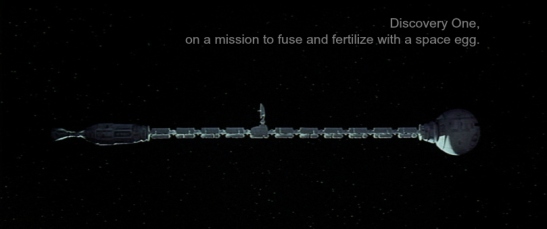
They play out an uneasy drama, not as a gay threesome as some commentators have noted, but as a love triangle between mankind, technology and the alien race. HAL is the only one aware of the discovery of the monolith (and the contact with a superior alien intelligence) and his judgement becomes clouded by anxiety over the mission and a fear of death, as well as good old paranoia and jealousy regarding being replaced in mankind’s affections by the aliens. When he spots Frank and Dave conspiring against him, HAL adopts the role of jilted lover, killing all the human crew apart from Dave Bowman, who he locks outside of the ship and refuses to talk to.
Like the previous protagonists, Dave must confront and defeat his rival before mankind can take an evolutionary leap forward. His tactic is to create a being free of the dehumanizing effects of technology but devoid of any human partners to reproduce with, he fires himself back into the ship via the emergency airlock and is then shown climbing upwards into the logic memory centre to deactivate HAL’s sentient state. Or to put it another way, he ejaculates himself into Discovery One’s vagina and ascends to its womb. The lighting in the air lock and logic memory centre is blood red, denoting the inside of the body. As he floats inside these zero-gravityspaces in his red spacesuit, Dave resembles an unborn baby.
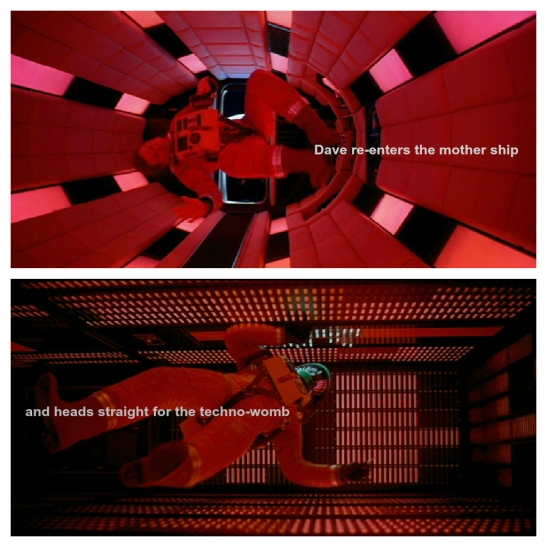
This regression back to the womb (and beyond the infinite) is echoed in the removal of HAL’s human emotions. As Dave deprogrammes HAL he is essentially deprogramming himself, stripping away the reliance on technology and reconnecting with his most human essence. The phallus that he uses to defeat HAL is the final one in the film and the smallest one of all, a key which disconnects HAL’s intelligence functions. HAL’s final attempt at reconciliation with Dave is singing him Daisy Bell, a love song about the blissful interaction between two humans and a new form of technology. Its all too late though as this particular relationship is over.
We cut to Dave in the EVA (extra-vehicular activity) pod, travelling to the third monolith, located at the end point of the lunar radio signal. The pod is essentially a cell for reproduction containing an element of human life (i.e. Dave) but, crucially, it no longer contains the damaging influences of HAL. When he reaches the monolith, Dave is sucked into a star-gate of brilliant light.
The star-gate sequence, for the purpose of this reading, is a visualisation of conception. Bowman’s EVA pod entering the star-gate can be read either as a sperm entering a pan-dimensionality vagina or a continuation his regression, a psychedelic experience as a means of escaping his dehumanized state and unlearning mankind’s dependency upon technology.
Following an opening light show, the star-gate visuals take on an organic quality, like magnified shots of embryos suspended in albumin, of blood and oomska. At one point Dave’s EVA pod enters the bottom right-hand of the shot and it leaves behind a trail (or sperm-like tail) of thick gloopy matter, denoting a collision between macro and micro cosmoses in which the outside once again becomes inside. The sequence concludes with a montage of shots of the Hebrides and Death Valley filtered and distorted with psychedelic effects, echoing the barren landscape shots at the start of the Dawn of Man segment and denoting a completion of the regression and a reconnection with Moon-watcher.
Before this tired reading can be laid to rest, Bowman must spend what feels like a life-time in the sterile and hospitalesque waiting room. He eats a final meal and, in symbolism rooted in the Judaic wedding ceremony (Kubrick’s parents were married with such a ritual), he commits to his new alien partners by breaking a wine glass. Before the birth can take place one more thing must happen. After all the metaphoric comings and goings, Bowman must undergo a literal death of the old self. The film ends with the forth and final monolith and Dave’s rebirth as the Star Child, heralding the start of something wonderful and the completion of this odyssey from adolescence (sexual awakening) to parenthood (sexual death).
